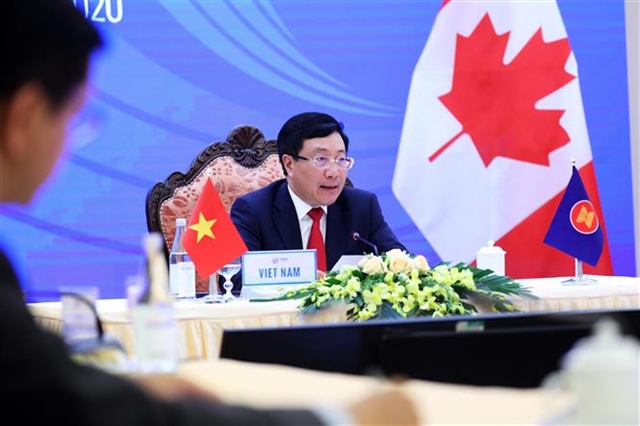 Politics & Law
Politics & Law

Việt Nam has taken advantage of the opportunity as the ASEAN Chair to become a bridge promoting intra-ASEAN connection as well as links between the bloc with its dialogue partners

|
| Việt Nam's Deputy Prime Minister and Minister of Foreign Affairs Phạm Bình Minh addresses the ASEAN-Canada Ministerial Meeting held online on Friday. VNA/VNS Photo Lâm Khánh |
HÀ NỘI – Việt Nam has taken advantage of the opportunity as the ASEAN Chair to become a bridge promoting intra-ASEAN connection as well as links between the bloc with its dialogue partners, a Canadian expert said.
In an interview with the Vietnam News Agency, Jonathan Berkshire Miller, Director and co-founder of the Ottawa-based Council on International Policy, highly valued Việt Nam's role in continuing to harmonise relations with China while striving to strengthen partnership within ASEAN and in the Indo-Pacific region as well.
"Việt Nam's chairmanship of ASEAN comes at a crucial time, both with the onset of the COVID-19 pandemic and also the continued geopolitical tensions in the region. It has been an unfortunate year for Việt Nam to take its leadership turn, because the pandemic has effectively stifled most of the important in-person meetings and dialogues.
"Việt Nam has rightly taken the opportunity to serve as a bridge and cohesion builder both with ASEAN and also to its dialogue partners," said Miller.
Miller, who is also a senior expert of the Asia Pacific Foundation of Canada, highlighted Việt Nam’s initiatives in changing the way it organises dialogues and important meetings during the year the country assumes its role as Chair of ASEAN when the COVID-19 pandemic is ravaging the world and geopolitical tensions in the region are escalating.
He stressed that Việt Nam's principled and resolved leadership has made progress in settling thorny issues related to the South China Sea (known in Việt Nam as East Sea).
Meanwhile, Luis Silva, a Canadian expert on government relations, expressed his optimism about the prospects of co-operation between ASEAN and Canada in the coming time.
"With the ongoing global pandemic of the novel coronavirus (COVID-19) and Canada's current diplomatic tensions with China, the Canadian government is seeking to become less reliant on the Chinese market and searching for new ways to expand its economic prospects with other countries in East Asia," said Silva.
"The Association of Southeast Asian Nations (ASEAN) is one way in which Canada can meet that objective."
According to the expert, Canada and four ASEAN countries, namely Việt Nam, Singapore, Malaysia and Brunei are signatories of the Comprehensive and Progressive Agreement for Trans-Pacific Partnership (CPTPP). Canada and ASEAN belong to the Joint Declaration on Trade and Investment and have begun exploring a possible free-trade agreement.
"These developments demonstrate that both parties are willing to deepen the co-operation further. However, as with any complex endeavour, the process to reach a consensus among multiple countries will take years to accomplish.
Canada and ASEAN are implementing a working plan under the Canada-ASEAN Joint Declaration on Trade and Investment, and considering the possibility of signing a free trade agreement, he said, noting that these show that both ASEAN and Canada want to deepen their co-operation.
The ASEAN-Canada dialogue partnership was established in 1977. In the framework of the ASEAN-Canada Ministerial Meeting held online as part of the 53rd ASEAN Ministerial Meeting (AMM 53) which ended on Saturday, the two sides discussed concrete measures to strengthen cooperation in political, social and cultural pillars.
Canadian Foreign Minister François-Philippe Champagne affirmed that as a nation in the Pacific, Canada attaches great importance to its growing relationship with all ASEAN member nations, and that his country and ASEAN can join hands to solve global important issues and support peace and security, economic growth and sustainable development for all countries.
ASEAN is now Canada's sixth largest trading partner. Two-way trade between Canada and ASEAN reached 27.2 billion CAD (US$20.6 billion) in 2019. Investment and trade activities of Canada in Southeast Asia have not only increased sharply in volume, but also covered many areas, including oil and gas, mining, high technology, telecommunications, food processing, financial services, and aviation. VNS